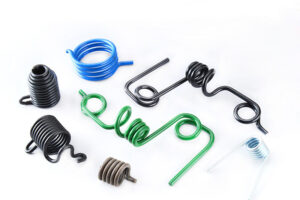Robotics Torsion Spring
 For a wide range of cutting-edge robotics applications, spanning from crucial robotic-assisted medical procedures to automated industrial workflows and even unmanned space exploration missions, the demand for top-notch precision Robotics Torsion Spring is paramount. Chinacustomspring takes pride in producing tailor-made springs and components that adhere to the most stringent requirements for industrial robotic systems.
For a wide range of cutting-edge robotics applications, spanning from crucial robotic-assisted medical procedures to automated industrial workflows and even unmanned space exploration missions, the demand for top-notch precision Robotics Torsion Spring is paramount. Chinacustomspring takes pride in producing tailor-made springs and components that adhere to the most stringent requirements for industrial robotic systems.
Our custom springs and components find extensive usage in various facets of robotic design and implementation, including:
1. Linear actuation for pushing or pulling mechanisms.
2. Rotary actuation for single-direction rotation or dual motion with a return to the center.
3. Counterbalancing articulated assemblies to ensure stability and flexibility.
4. Cable assembly and management for efficient organization and operation.
5. Propulsion systems for movement and control.
6. Steering mechanisms for precise navigation and maneuverability.
For inquiries regarding components mentioned earlier or bespoke devices, please get in touch with our sales and design engineering teams for personalized assistance.
Robotics Torsion Spring Components
We provides a wide array of mechanical components tailored for robotics applications. Among the key products are constant force springs, spiral torsion springs, and spring reels, each offering unique benefits:
- Constant force springs: Deliver a seamless range of motion with a consistent load during extension or retraction, potentially eliminating the requirement for complex motors and reducing device size and cost.
- Spiral torsion springs: Ideal for applications needing less than 360 degrees of rotation, enabling significant torque with minimal rotation.
- Spring reels: Available in various forces, cable lengths, and travel options, ensuring easy mounting and diverse application suitability.
In addition to the aforementioned products, we specialize in designing and manufacturing custom mechanical assemblies. Often, clients require additional components that necessitate integration with the spring. In such scenarios, a custom mechanical assembly proves to be the optimal solution. Our engineering team excels at identifying assembly requirements during the design phase.
Comprehensive Manufacturing Support
From initial design concepts to prototyping, our serves as your trusted contract manufacturing partner for robotic mechanical components. Our dedicated engineering team works diligently to verify design specifications, minimizing development costs and lead times. We assess whether standard springs, custom variants, or specialized assemblies best suit your device requirements.
With comprehensive in-house tooling capabilities and stringent quality control measures, we offer unparalleled support and exceptional customer service throughout the manufacturing journey. Connect with us to explore collaboration opportunities with America’s Oldest Springmaker.
Require Assistance? Engage with our Technical Team.
Our adept Technical Team stands ready to provide expert guidance across all phases of your project. Timely responses to your queries and precise identification of your needs are among our top priorities. Whether you seek custom Robotics Torsion Spring for specific applications or have bespoke customization requirements, we are committed to partnering with you to achieve optimal outcomes.






